

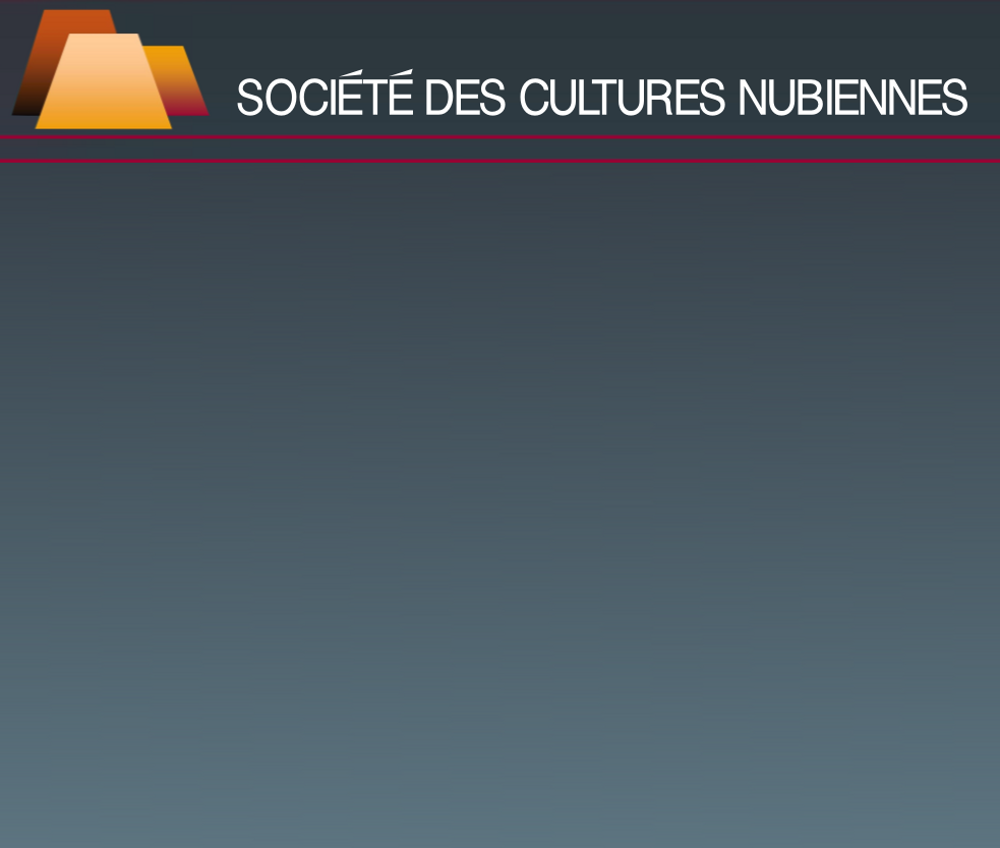
| THIRD GROUP AT KHOR INGI : The temple of Kalabsha, lthe speos of Beit el-Ouali, the kiosk of Kertassi (west bank)
The temple of Kalabsha
Originally this temple was located on the Tropic of Cancer some 50 km south of Aswan. On each side of the river the rocks formed a defile that the locals called the 'Gate of Kalabsha'. In the Greek period, the town was called Talmis.
The rescue excavations of the R.F.A. continued a tradition begun in the middle of the XIX Century (Lepsius expedition between 1843 and 1848). In 1819, Kalabsha was inventoried by the architect Franz Gau. Maspero described it as one of the most beautiful Nubian temples of the Late Period and Henri Gauthier published it (Submerged temples of Nubia 1911-1914).
Today it is located on the site of Khor Ingi behind the High Dam. More than sixteen thousand blocks weighing some thirty tons were dismantled. The rescue excavations found the remains of a Ptolemaic gate, today re-erected in the Museum of Berlin. The king Ergamenes and the emperor Augustus participated in the reconstruction of the temple, whose first version was built under Amenhotep II, a ruler of the XVII Dynasty.
The temple, oriented east-west, has an entrance pylon slightly out of alignment in relation to the central axis. A landing stage with a 72 m long staircase gave access. The temple was built on a Greco-Roman model with intercolumnar walls and composite capitals. The walls are covered with reliefs and numerous hieroglyphic texts.
The main god, Mandulis, is represented under form of the falcon assimilated to Horus (son of Isis and Osiris). |
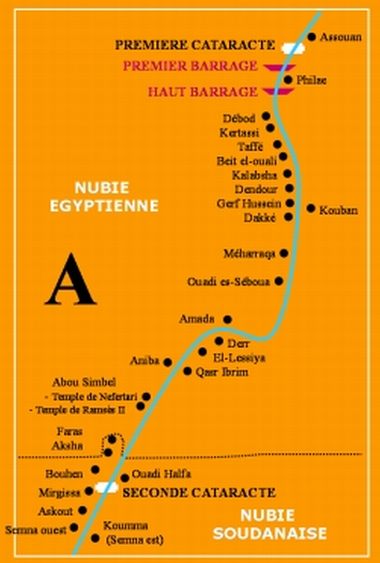 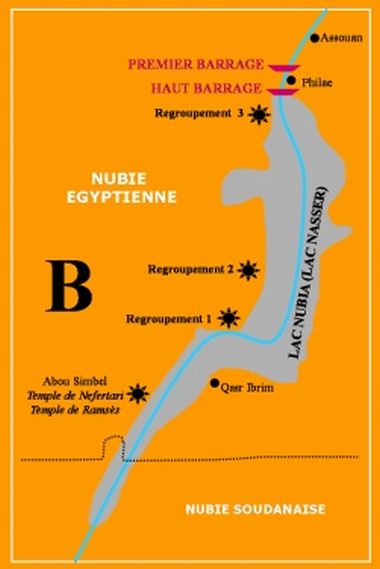 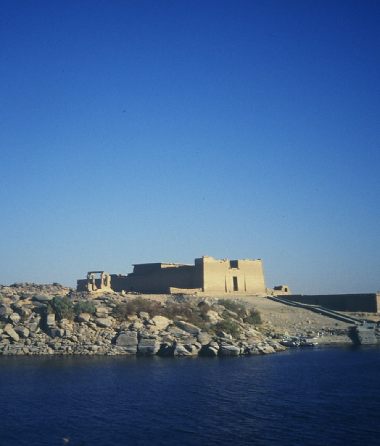 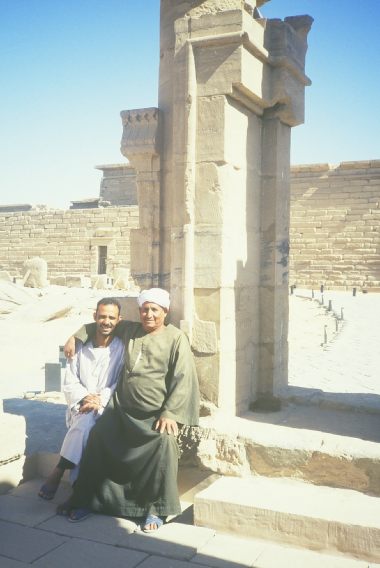 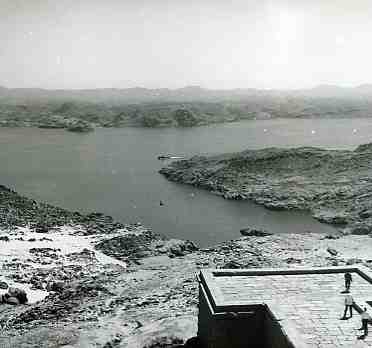 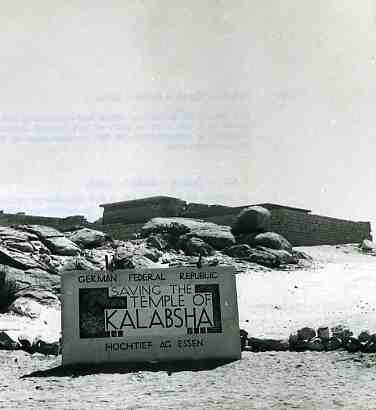 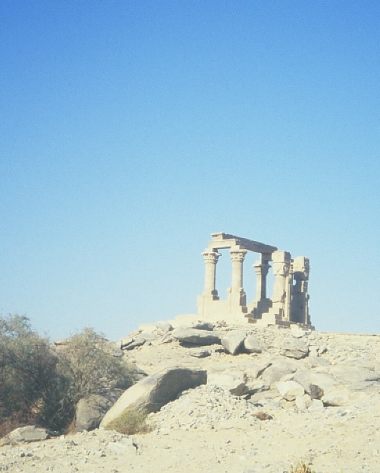 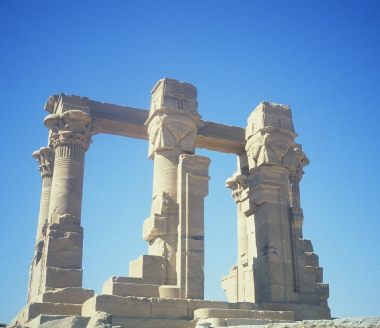 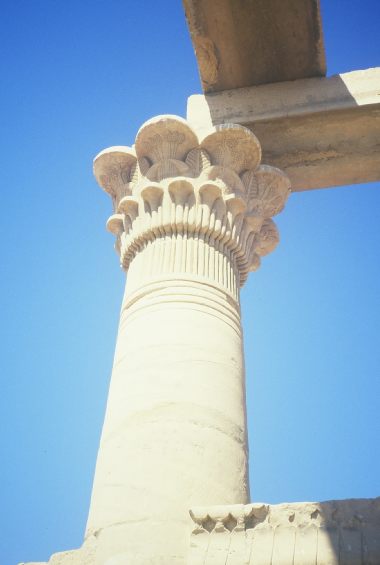 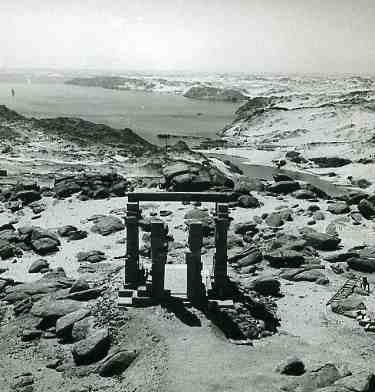 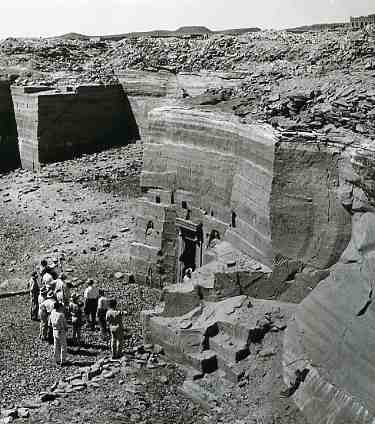 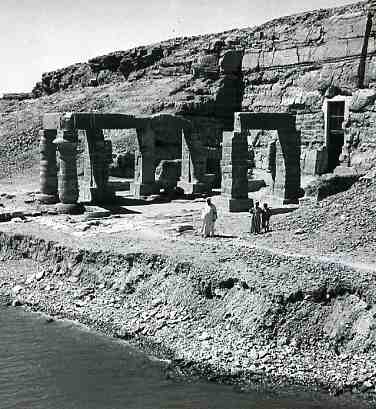 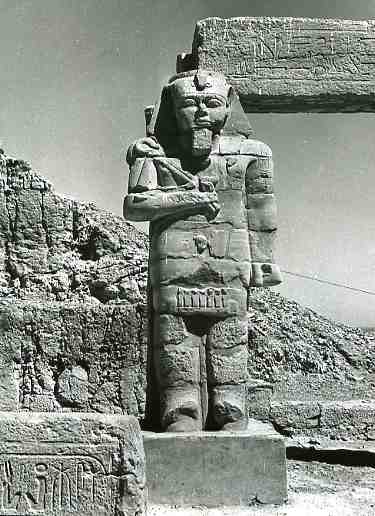 Temples and fortresses along the Nile Valley before the building of the High Dam of Assouan / Temples et forteresses de la vallée du Nil avant la mise en eau du Haut-Barrage d'Assouan
Gathering of the temples along the Nile valley after the building of the High Dam of Assouan / Regroupement de temples de la vallée du Nil après la mise en eau du Haut-Barrage d'Assouan
Kalabsha temple rebuilt by the German Federal Republic between 1961 and 1965 near the High Dam / Temple de Kalabsha reconstruit par la RFA entre 1961 et 1965 près du Haut-Barrage d'Assouan
Entrance of Kalabsha temple / Entrée du temple de Kalabsha
Tropic of cancer (called also door of Kalabsha) situated at about 50 km south from Assouan, where the temple had been built before (photo R. Keating 1960) / Tropique du cancer (appelé aussi porte de Kalabsha) situé à une cinquantaine de kilomètres au sud d'Assouan où avait été construit le temple (photo R. Keating 1960)
Kalabsha temple before its reconstruction near the High Dam (photo R. Keating 1960) / Temple de Kalabsha avant sa reconstruction près du Haut-Barrage (photo R. Keating)
Kertassi kiosk bound to shelter the bark used to carry the statue of the goddess Isis during the pilgrimage over Lower Nubia / Kiosque de Kertassi destiné à abriter la barque utilisée pour transporter la statue de la déesse Isis lors de pélerinages en Basse-Nubie
Kiosk of Kertassi (see the former picture) with hathoric chapiters / Kiosque de Kertassi (voir légende précédente) avec des chapiteaux hathoriques
Kiosk of Kertassi (see the former picture) with composite chapiters / Kiosque de Kertassi (voir légende précédente) avec des chapiteaux composites
The Kertassy kiosk in its natural background (Photo R. Keating 1959) / Le kiosque de Kertassi dans son environnement d'origine (Photo R. Keating 1959)
Kertassi quarriers situated on the western side of the Nile at about 50
km south from Assouan. The stones extracted had been used to build the
temple of Philae. The quarry has a shape of amphitheater. Two corners
with statues, give to the site, a special character (Photo Unesco/Mariani
1959) / Carrières de Kertassi situées sur la rive occidentale du Nil à
environ une trentaine de km au sud d'Assouan. Les pierres extraites ont
servi à la construction du temple de Philae. La carrière a une forme
d'amphithéatre. Deux niches ornées de bustes donnent à ce site un
caractère inhabituel (Photo Unesco/Mariani 1959)
Gerf Hussein temple which was situated at 90 km south from Assouan on the left side of the Nile. It has been dedicated to the god Ptah by Ramses II (Photo R. Keating 1960) / Temple de Gerf Hussein qui était situé à 90 km au sud d'Assouan, sur la rive gauche du Nil. Il fut dédié au dieu Ptah par Ramsès II (Photo R. Keating 1960)
Statue of Ramses II in the yard of the temple of Ptah of Gerf Hussein (Photo R. Keating 1960) / Statue de Ramsès II dans la cour du temple de Ptah de Gerf Hussein (Photo R. Keating 1960)
|
| On the pylon there are two references to the victory of Christianity in Lower Nubia when the temple was transformed into a church: 'I, the priest Paulos, have prayed here for the first time...' and 'I have raised the cross for the first time in this place'. Another inscription refers to the king of the Nobades, Silko. The text, in bad Greek, mentions the victory of the ruler over another ethnic group, the Blemmyes. Silko is thought to have converted to Christianity in AD 543.
The peristyle court presents some reliefs, among which Ptolemy IX offering a field to Isis, Mandulis and Horus, while Amenhotep II faces the gods Mandulis and Min. There are also Roman inscriptions from the II and III Centuries when the empire had garrisons in Lower Nubia. The decurion Maximos had this prayer inscribed: 'Be merciful, o Mandulis, and incline your head towards me to express your blessing! Save me and save my beloved spouse and my dear children! I constantly appeal to You that my companions should be delivered from all sickness and all hard work and that we should be able to return to our country. How happy are the people that live in the holy city of Talmis, beloved of Mandulis, the sun god who is under the sovereign authority of Isis, the goddess with the beautiful hair and with the many names!'
The decoration of the hypostyle hall was carried out under the reigns of Trajan and Antoninus Pius (II Century AD). There are scenes of ritual adoration and offerings to the gods Mandulis, Min, and Khnum. Also present is the god Dedun, god of incense and the venerated Imhotep, considered during the Late Period as a healing god assimilated with Aesculapius.
Two vestibules lead to the Holy of Holies. The decoration consists of scenes of adoration and classic offerings. On the rear side of the back wall of the sanctuary, Mandulis is depicted on the right as a king with a crown, sceptre and ankh sign and on the left as divine, wearing a headdress with rams horns, solar disc and uraeus.
During his visit to Kalabsha on the 27th of January 1829, Champollion showed his understanding of the complexity of the Egyptian pantheon, beginning with the 'Great Being' because 'these secondary forms establish a broken chain that descends from the heavens and materialises as incarnations on earth and under human form. The last of these incarnations is that of Horus'.
This kiosk, a barque repository, is part of the remains of a small ancient temple dedicated to Isis. It lay some 10 km north of Talmis (Kalabsha) and 30 km from Aswan, between the temples of Debod (given to Spain) and Taffe (today in Leiden, Holland). It was built under Trajan (AD 98-117) by the architects of Philae. Four columns with composite capitals and two Hathor pillars are all that remains; today its location on a slight rise reproduces the impression that it gave in its original setting. It is very likely that this small structure is part of the Isis sanctuaries that were the focus of pilgrimages organised by the local Nubian populations. The statue of the Philae temple was carried through all of Nubia to bless the land. The hemi-speos of Beit el-Wali ('the house of the Saint')
This small temple, to the north of the pass of Kalabsha, was built under Ramses II. The entrance, flanked by two towers, gave access to a court and then to a vestibule and a sanctuary excavated from the rock. This construction seems to enthuse Champollion: 'there, my eyes were consoled after the barbaric sculptures of the temple of Kalabsha, that were made rich because one no longer knew how to make them beautiful (at Talmis, there were still colours on the walls, including gold), in contemplating the historical reliefs that decorate this speos in a very beautiful style, which we have complete copies of. These tableaux relate to the campaigns against the Arabs (Semites from Canaan, Syro-Palestinians) and the African peoples of the land of Kush at the Third Cataract'. Its distinctive feature is the historic narrative illustrated in the courtyard, today open to the skies. The Asiatic and African peoples are dominated by the great Ramses. On the south wall, the viceroy of Nubia is escorted by his officers, presenting the Nubians' tribute: cattle, wild animals, monkeys, gazelle, giraffes and precious metals in the form of circular gold ingots. On the north wall are Syrian war scenes. The king is mounted on his chariot and pursues the fleeing population. He attacks a fortress and the Syrians implore his clemency. He treads the vanquished populations underfoot. In the vestibule are classic scenes of offerings that show Ramses in the company of deities such as Isis and Anukis facing Horus of Buhen and Selkis, or Satis and Khnum. The sanctuary shelters three much deteriorated statues, but at the by comparison with other speos, we may suppose that the ruler was flanked by Amun and Ra-Horakhty. The dismantling and re-erection of this speos were carried out thanks to a grant from the United States. Between 1961 and 1965 Egypt undertook the work.
|
|